When looking for activity and movement in your aquarium, it is difficult to deny the appeal of a school of fish moving fluidly through the water.
The terms “school” and “shoal” are used often (frequently interchangeably) to mean “a group of fish.”
However, if you are looking to add schooling fish to your tank, you should know the definitions and behaviors that define these fish so you get exactly what you want.
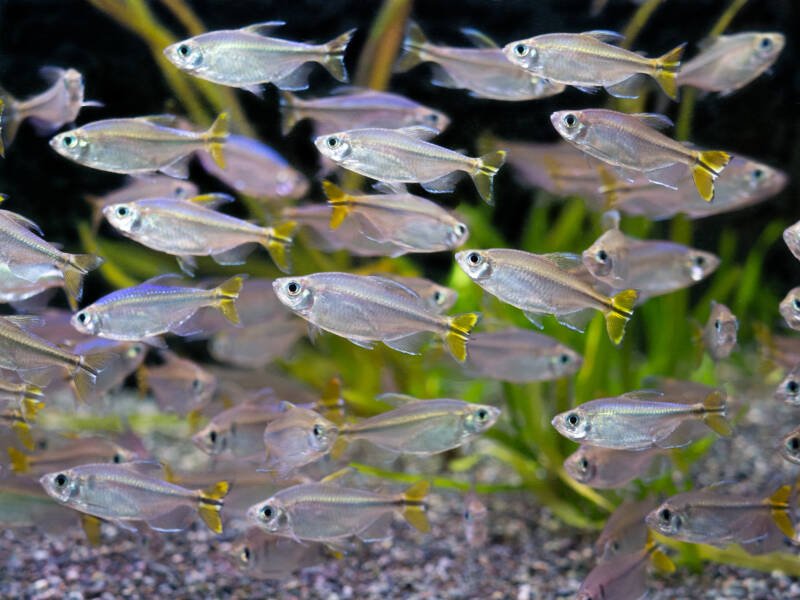
In this article, we define schooling versus shoaling, give general recommendations to promote the behavior in a home aquarium, and list our favorite schooling species (plus a few interesting shoaling types to consider).
In this article
What are “Schooling Fish?”
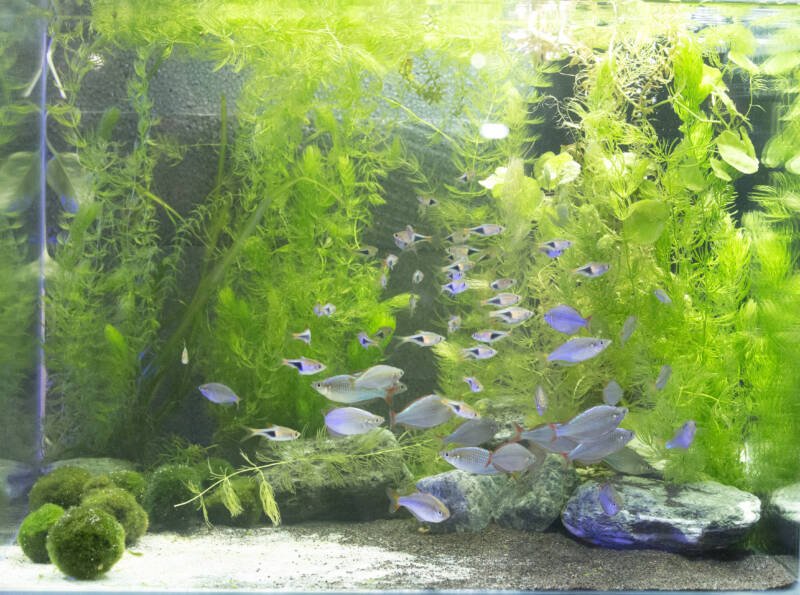
Many fish species school at some point in their lives. For example, fry or juvenile fish may stick close together for protection but may not school as adults.
For both young and adult fish, schooling provides safety in numbers as well as multiple pairs of eyes on the lookout for predators. Having many sets of eyes is also useful when it comes to finding food.
Then, there is the hydrodynamic aspect of swimming in a group. As the lead is changed, one can draft behind the fish in front, thereby conserving energy over swimming alone.
Finally, let us not forget that a large group makes it more likely for a fish to find a mate and reproduce. Likewise, for those egg-scattering species, a large school means better odds of having the eggs fertilized.
In an aquarium, schooling fish are more colorful, healthy, and calm. Schooling behavior also helps to dampen or disperse any aggressive behaviors within the school and toward other species in the tank.
Fish kept in adequately sized schools are less stressed and more active.
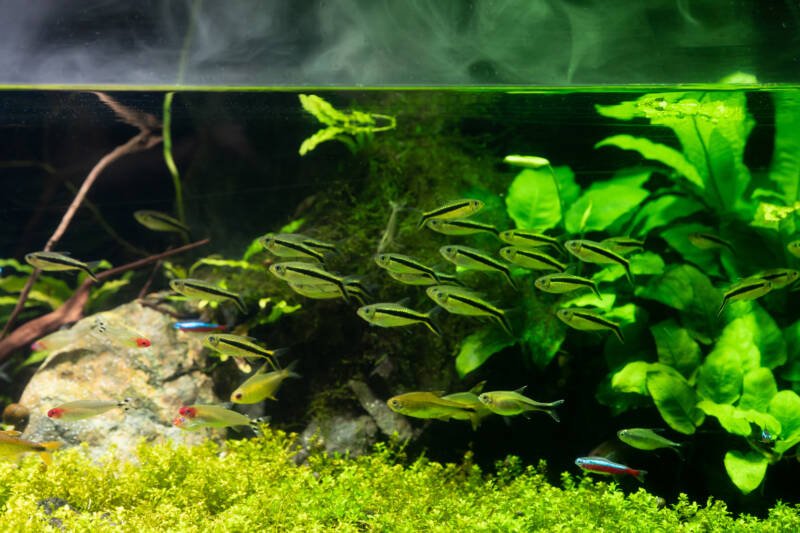
True schooling fish exhibit the behavior throughout their life cycle. Many species of tetra, danio, barbs, and rasboras, as well as some Corydoras and loaches, fall into this category.
Other species, such as cardinals, neon tetras, Endler’s livebearer, and tiger barbs, will only school in response to a threat. The rest of the time, they remain loosely grouped and spread out around the tank.
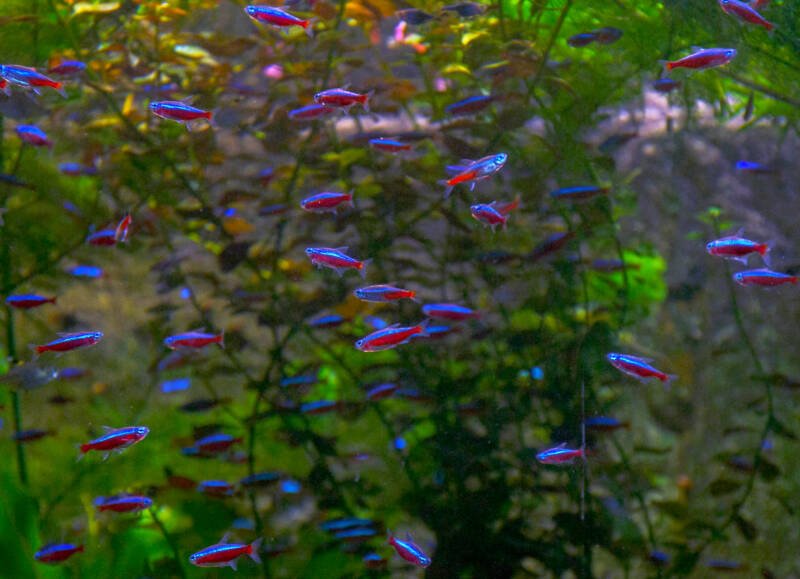
Schooling Versus Shoaling
In general, a school of fish will face the same direction, move at the same speed, turn together, group tightly as a unit, consist of the same species, and usually has a purpose (i.e., moving somewhere or finding food).
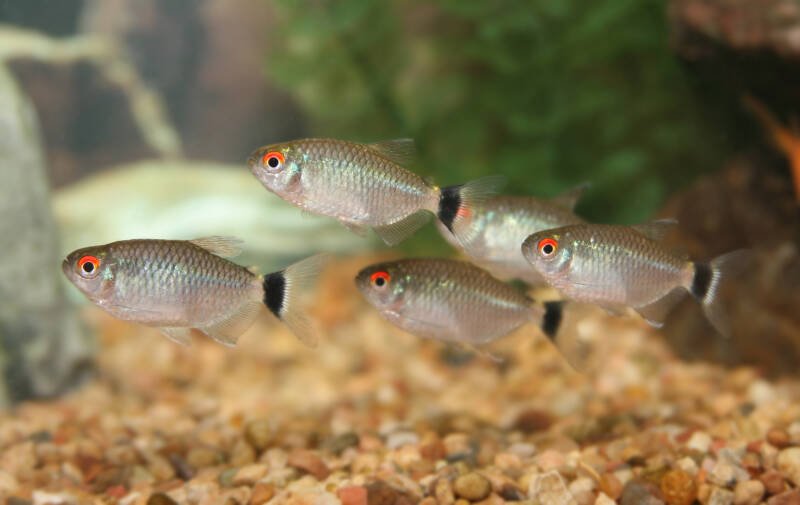
Shoaling fish, on the other hand, do not always group together. If they do, the groups are loosely organized. These fish prefer the “nearby” comfort from other fish. It can be from their own species or another species entirely.
A group of fish schools and stays together using sight, pheromones, lateral line sensations, and even smell.
Each fish tries to keep the same distance and orientation as their neighbor when in motion. When the school is at rest, it becomes a shoal, with the fish remaining in proximity.
Tank Conditions to Promote Schooling
Natural behavior aside, the most important aspect to promote schooling is the environment where you place your fish.
Water Parameters
Always maintain the appropriate water parameters for the species you choose.
Remember that fish kept on the far ends of their tolerance ranges will constantly be in a state of stress! This stress can lead to aggression and disrupt schooling behavior. Not to mention, stress makes your fish vulnerable to infection and illness.
Stocking Numbers and Tank Size
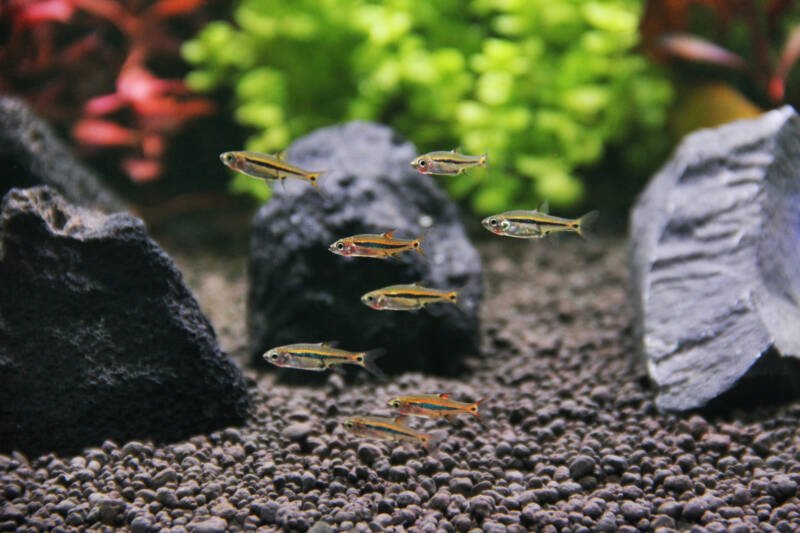
Schooling fish need adequate numbers of their own kind to form a “school.” This number varies depending on the species; however, most need around six specimens.
Follow the guidance from your breeder, store, and other reputable sources regarding school size to encourage the healthiest behaviors from your fish.
Some fish become stressed if kept in too small of a school. Others school for a specific purpose, such as to spawn, and are comfortable in a smaller group. Still, others do well in a small group as long as there are other similarly sized fish in their location.
Keeping your fish in too small of a tank can impact their ability to school properly, so pay attention to recommended tank sizes.
Most recommendations consider the need for a school and are intended for a single species tank. Adding other species or a larger school size will require you to increase tank size accordingly.
Tank Mates
Researching the temperaments and behaviors of species you intend to pair in a community aquarium is paramount.
Species that may be perfectly peaceful on their own may create stress if they are overactive, boisterous, territorial, or occupy the same levels of the water column. Compatible tank mates promote healthy schooling.
Recommended Schooling Fish
The following are our top picks for excellent schooling species:
1. Rummy Nose Tetras (Hemigrammus bleheri)
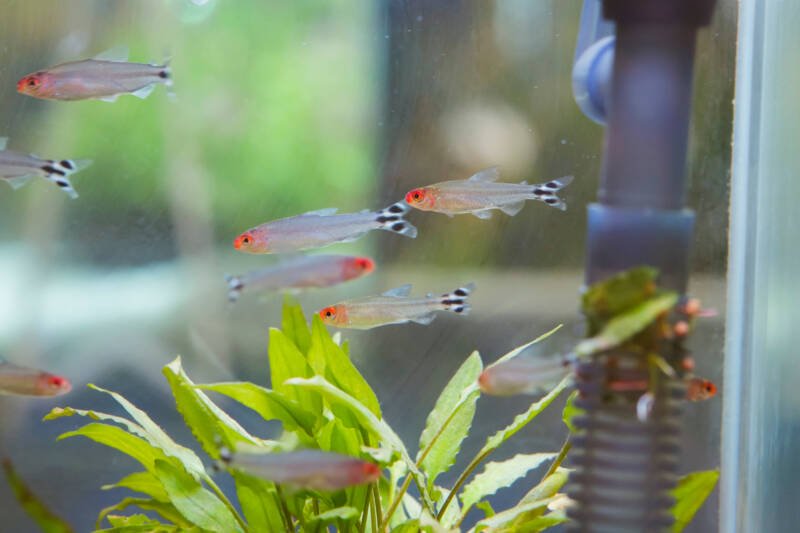
Minimum Tank Size: 20 gallons
Rummy nose tetras are one of the tightest schooling species in a home tank setting.
While they will spread out as they become comfortable with their environment, they will frequently come back together, swim from one end of the tank to the other, or cluster in one spot.
Their silver bodies and bright red heads look amazing when they school. Plan on keeping at least six of these 2.5-inch-long (3.4 cm) fish in a decent size tank.
These active fish prefer the middle levels of the water column and need plenty of swimming space.
2. Congo Tetras (Phenacogrammus interruptus)
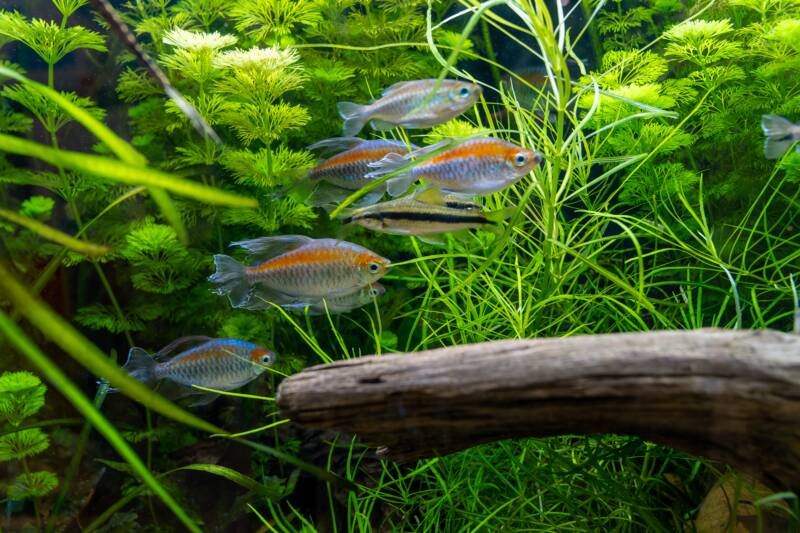
Minimum Tank Size: 30 gallons
This peaceful fish from the Congo River Basin reaches anywhere from 2.5 to 3.5 inches (6.4 to 9 cm) fully grown.
They need a group of six to be comfortable and are prone to be bullied by other fin nipping species.
Congo tetras are shy and benefit from the inclusion of floating plants and vegetation in their tank. They will duck into these areas if they feel threatened.
These fish favor the middle to upper water levels and get along well with other schooling species, especially those that stay in the middle to bottom areas.
3. Ember Tetras (Hyphessobrycon amandae)
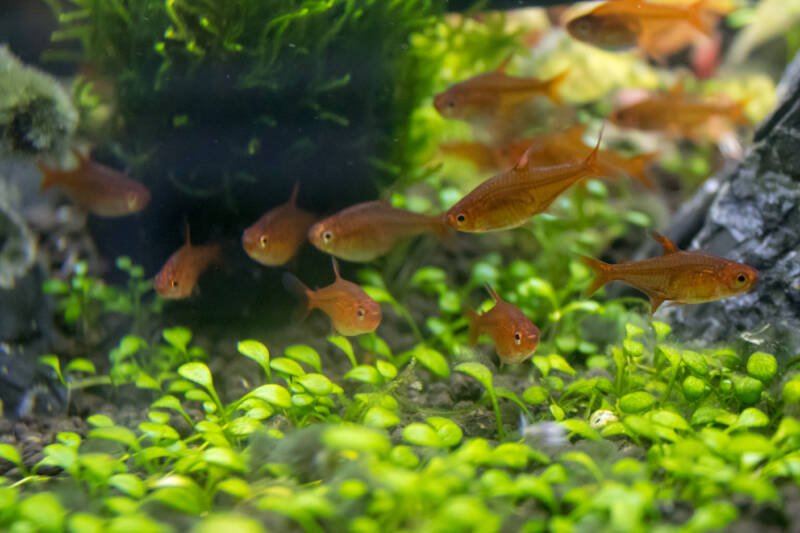
Minimum Tank Size: 10 gallons
At a tiny adult size of 0.6 to 0.8 inches (1.5 to 2 cm), ember tetras are an excellent choice for an aquarist short on tank space.
A school of these little guys makes a rippling fabric of gently glowing orange. Keep a minimum of six to eight fish. They will school both with their own kind and with other small tetras.
Ember tetras need very small foods. Be careful not to overfeed these fish as they can be prone to impaction. Do not pair these fish with larger species that may consider them as food.
4. Diamond Tetras (Moenkhausia pittieri)
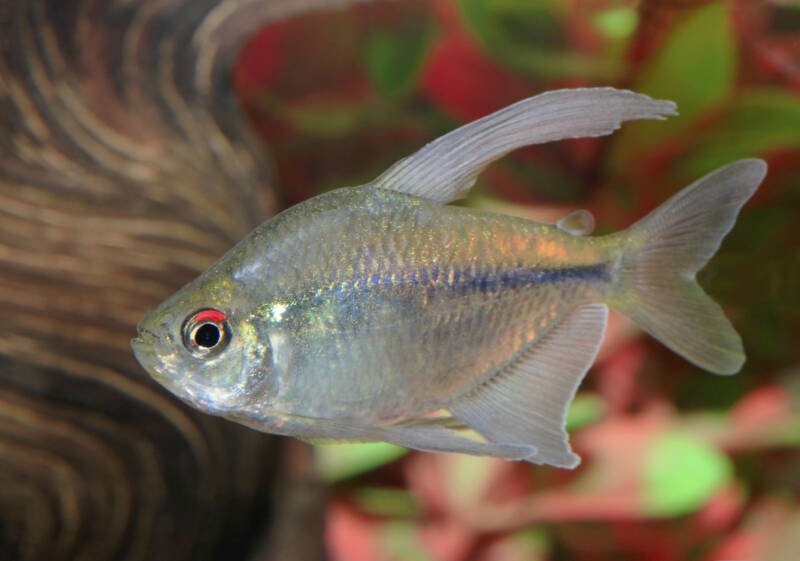
Minimum Tank Size: 15 gallons
A school of diamond tetras glitters like their namesake gem in the sun. They reach an adult length between two to 2.4 inches (5 to 6 cm) and have a hardy nature that makes them perfect for beginning aquarists.
They are peaceful, yet active, and need a good amount of swimming space bordered by live plants. Keep them in groups of odd numbers (3, 5, 7, etc.).
While they get along well with other species in a community tank, avoid larger or overly aggressive fish.
5. Black Skirt Tetras (Gymnocorymbus ternetzi)
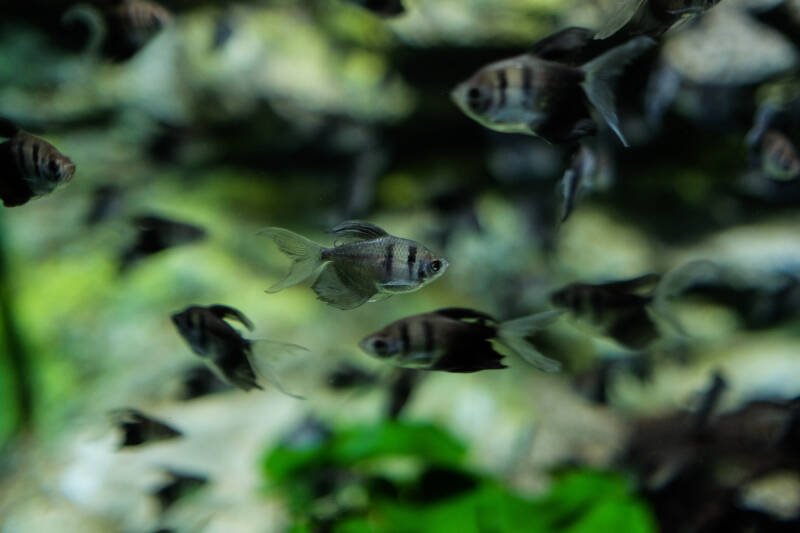
Minimum Tank Size: 15 gallons
Black skirt tetras have a shimmering black/grey color and uniquely shaped fins. Three inches (7.6 cm) in length is the largest they will get, so tank size is reasonable.
These fish occupy the middle levels of the tank. Plan on having some tall plants for them to swim through.
They school well, although you may see one or another exploring on its own from time to time. Five fish is the minimum school size.
Other tank mates are fine, provided they do not have trailing, flowing fins, which will tempt the black skirts into nipping.
6. Bloodfin Tetras (Aphyocharax anisitsi)
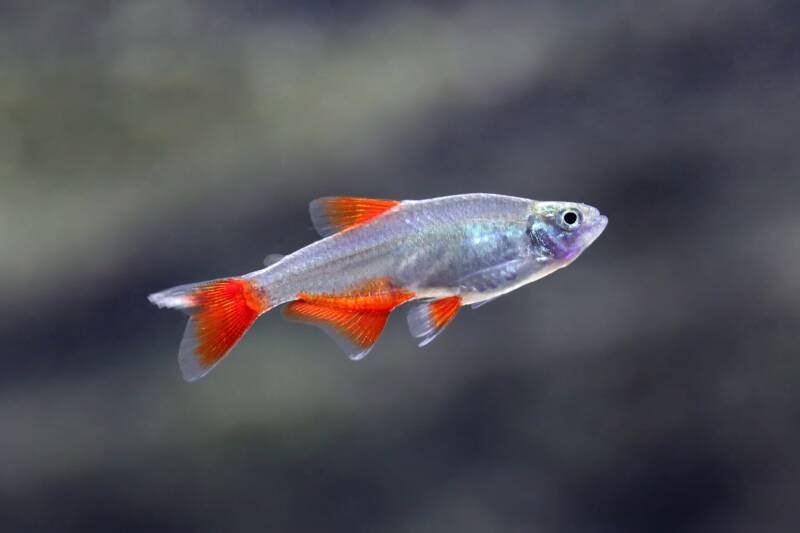
Minimum Tank Size: 10 gallons
The bloodfin tetra schools near the top of the tank. Install a tight-fitting aquarium lid to prevent them from leaping out if startled.
They are active, hardy, and able to tolerate cooler water temperatures than other tetra species. As such, they are an excellent choice for someone new to aquarium keeping.
Keep this two-inch-long (5 cm) fish in a group of at least six. In this group size, activity is confined to the school.
Smaller groups will lead to increased aggression, with your tetras nipping at slower swimming or long-finned fish.
7. Glass Catfish (Kryptopterus minor)
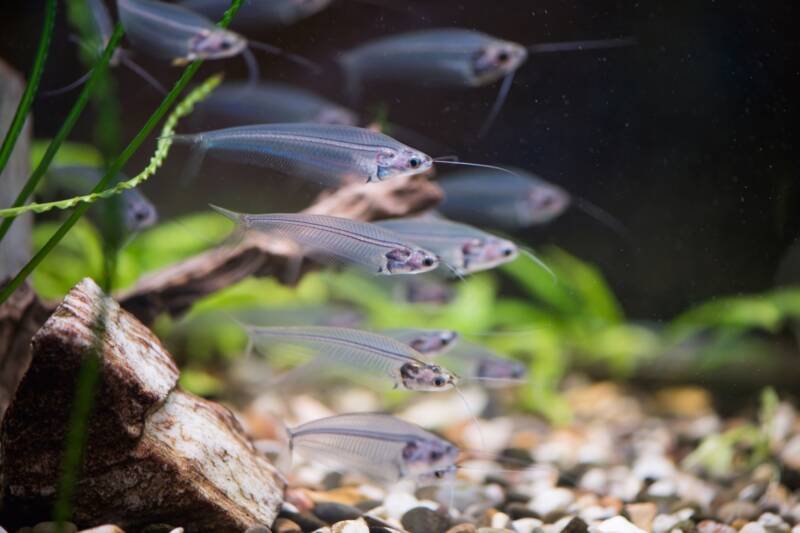
Minimum Tank Size: 30 gallons
The glass catfish is sure to capture your attention with its fully transparent, three-inch-long (7.6 cm) body giving a view of the spine, bones, and organs.
These fish are active during the daytime, grouping together both to feed and linger perfectly aligned in the current. Set up your tank with pockets of lush vegetation to provide safe spaces.
While they are bold during feeding times, it can be tricky to make sure your glass catfish have adequate food. If your catfish are housed with more aggressive fish, they can be easily outcompeted for resources.
8. Otos (Otocinclus)
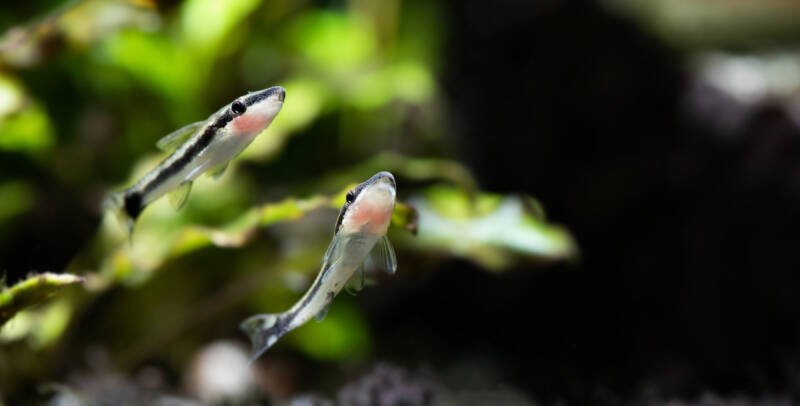
Minimum Tank Size: 10 gallons
Cute and tiny, otos are prized for their peaceful nature and their algae-eating prowess.
There are 22 Otocinclus species, ranging in size from just under one inch (2.4 cm) to just over two (5.5 cm). These fish favor the bottom of the tank, so a soft substrate is necessary.
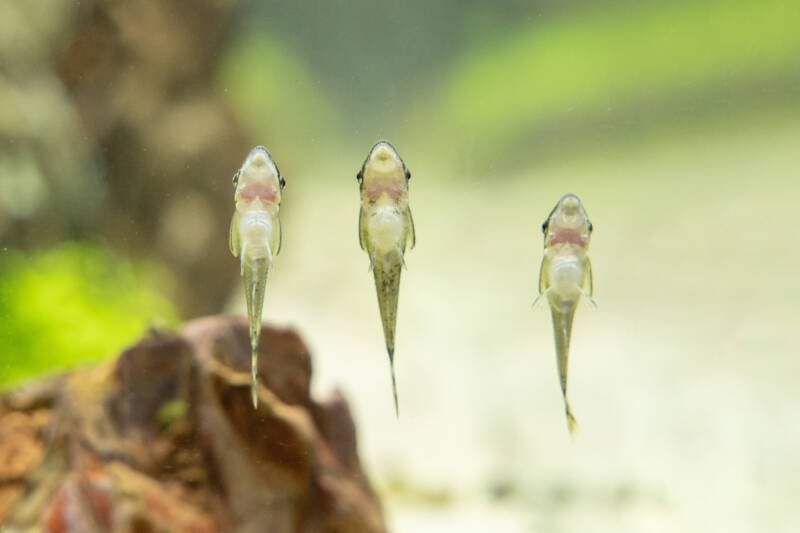
Keep these fish in a school of at least four to six. Armored and fast swimming when they need to be, otos can live happily with many other species.
In addition to algae and biofilm, they need supplementation with zucchini or algae wafers to be healthy.
9. Harlequin Rasboras (Trigonostigma heteromorpha)
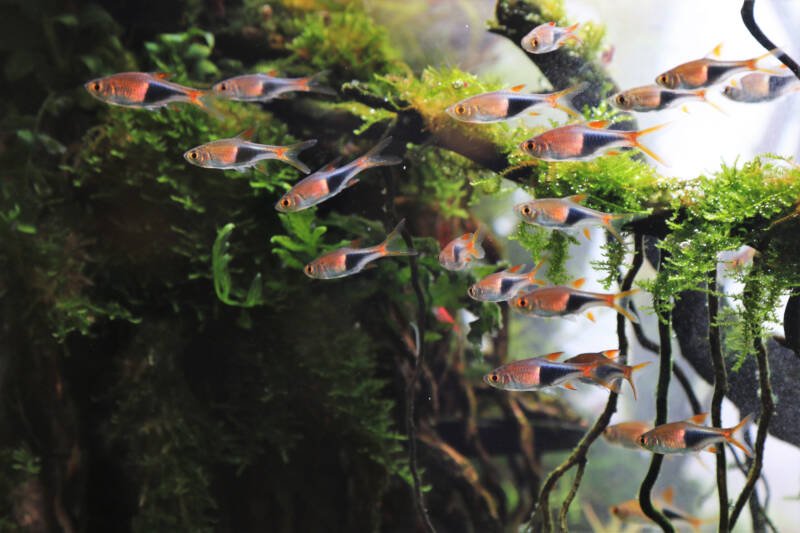
Minimum Tank Size: 10 gallons
Harlequin rasboras look amazing in a school with their pink/orange color and contrasting dark triangle shape near their tail.
Their tank size needs are smaller as they only reach two inches (5 cm) fully grown.
You will need a group of eight to 10 fish to bring out their most active behaviors. Larger groups in larger tanks look even better! The harlequin rasboras will stick together and explore the tank.
You can add these schools to community tanks, just make sure that the other inhabitants are not overly large or aggressive.
10. Chili Rasboras (Boraras brigittae)
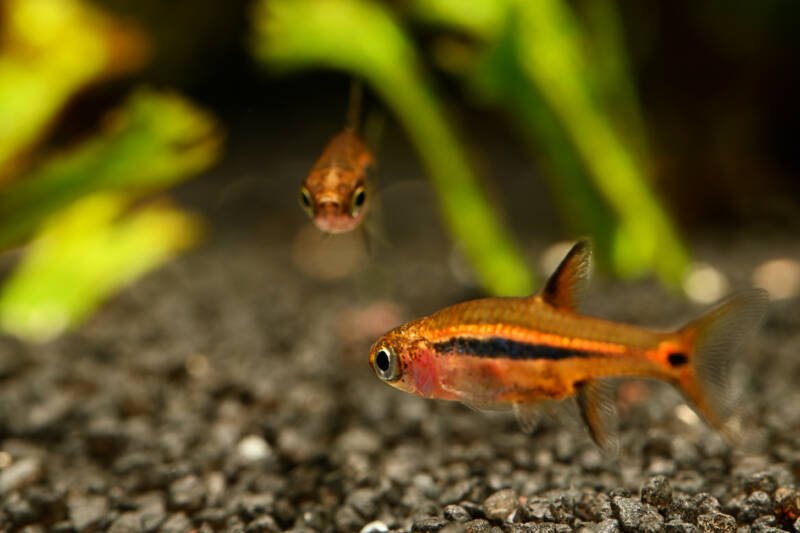
Minimum Tank Size: 5 gallons
Place a large group of tiny, 0.7-inch (1.8 cm) sized chili rasboras in a tank, and you have an impressive display! Their fire red body color is accented by an even brighter red stripe atop a darker black one.
These fish need a blackwater tank with stable water conditions, plenty of plants, and a low water current.
Chili rasboras stick to the upper half of the aquarium, where they group and swim together.
They need small-sized foods and pair well with similarly sized fish or those occupying the lower levels of the tank.
11. Scissortail Rasboras (Rasbora trilineata)
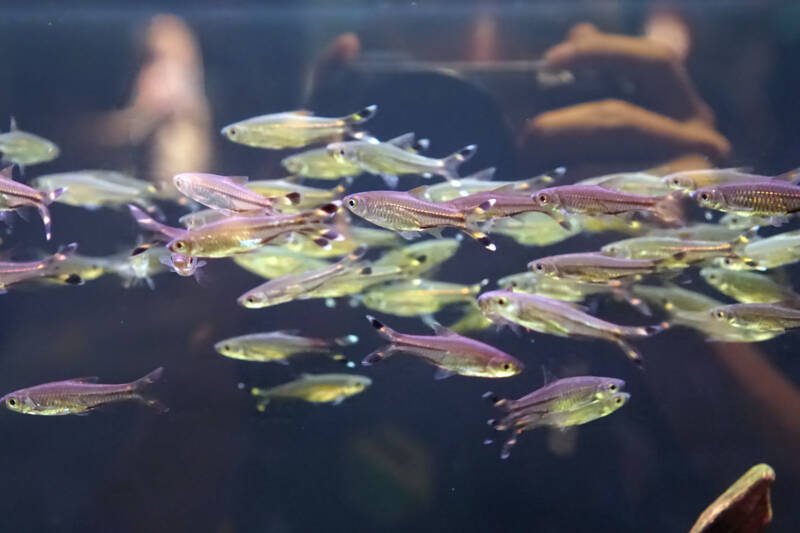
Minimum Tank Size: 70 gallons
Scissortail rasboras have a deeply forked tail that they can manipulate in a manner resembling the movement of scissors.
They dwell in the middle to upper levels of the tank, where they energetically school and swim.
Give these six-inch (15 cm) fish a long tank with subdued lighting to make them comfortable.
Keep scissortails in a group of six or more for the best behavior and coloration. While this peaceful fish does well with other tank mates, ensure any other fish you add also prefer the acidic waters favored by the scissortails.
12. Cherry Barbs (Puntius titteya)
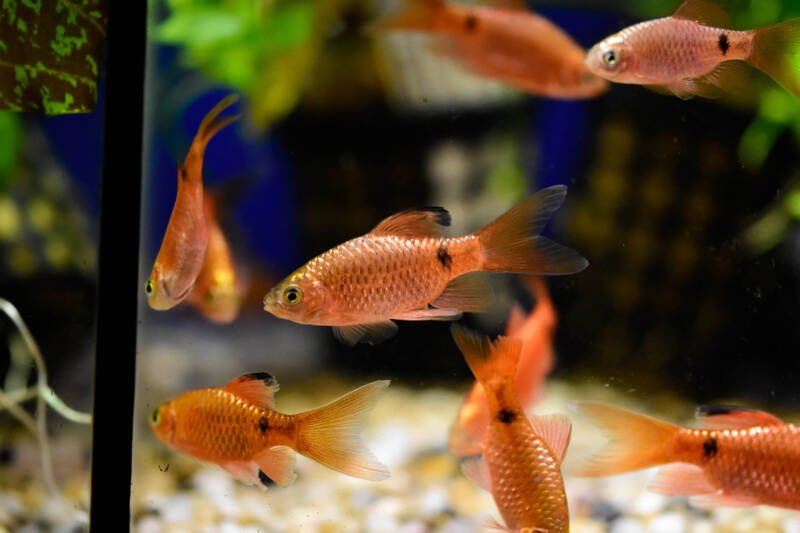
Minimum Tank Size: 25 gallons
The head, body, fins, and even the eyes of the cherry barb are a beautiful, bright red.
These hardy fish will not grow larger than two inches (5 cm) and tolerate a wide range of water conditions. They are most comfortable in a lush tank with planted and floating vegetation.
Cherry barbs school in the middle areas of the tank.
A group of six with a higher female to male ratio is best to prevent them from hiding due to shyness. If you have a large enough group, you may see them split into smaller schools of a male with several females.
13. White Cloud Minnows (Tanichthys albonubes)
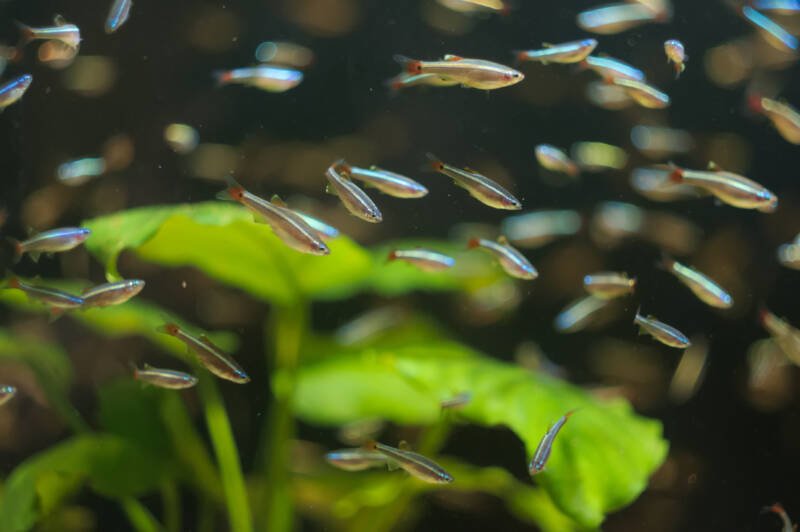
Minimum Tank Size: 10 gallons
If you are looking for a cool water schooling fish, consider the white cloud minnow. “Poor man’s neon tetra” stay small at around an inch to an inch and a half (2.5 to 3.8 cm) in length, and for a reasonable price, you can get a school of six.
Their brown/bronze bodies have a horizontal stripe terminating in a black dot.
These active fish explore and feed as a group. They are peaceful, outside of breeding times, and are suitable for community tanks.
When choosing tank mates, consider small fish that also need cooler water.
14. Clown Loaches (Chromobotia macracantha)
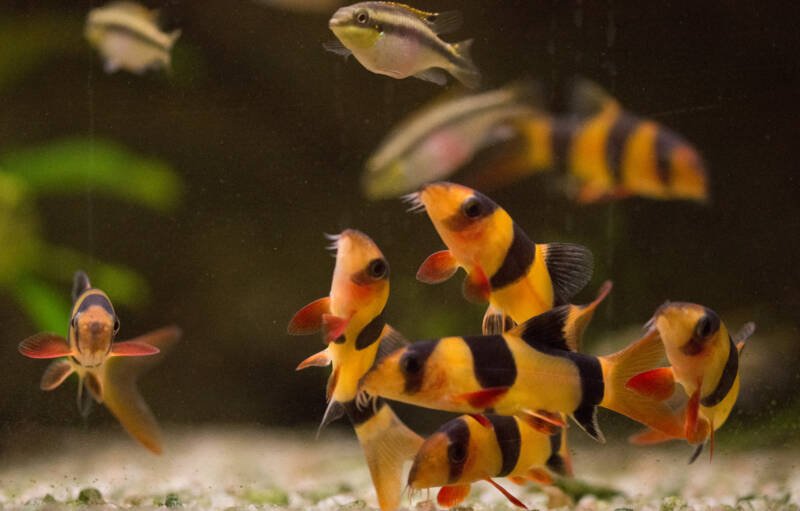
Minimum Tank Size: 150 gallons
For larger aquariums, the colorful clown loach is a fantastic addition. Do not underestimate the ultimate size of these fish, as the cute, little two-inch (5 cm) fish you purchase will steadily grow to around 12 inches (30 cm) as an adult.
A well-planted tank with plenty of hiding spaces and low lighting is necessary for keeping a group of five clown loaches. When together, these fish will playfully interact and exhibit confident behavior.
Clown loaches are non-territorial, peaceful, and stick to the lower levels of the tank.
15. Zebra and Leopard Danios (Danio rerio)
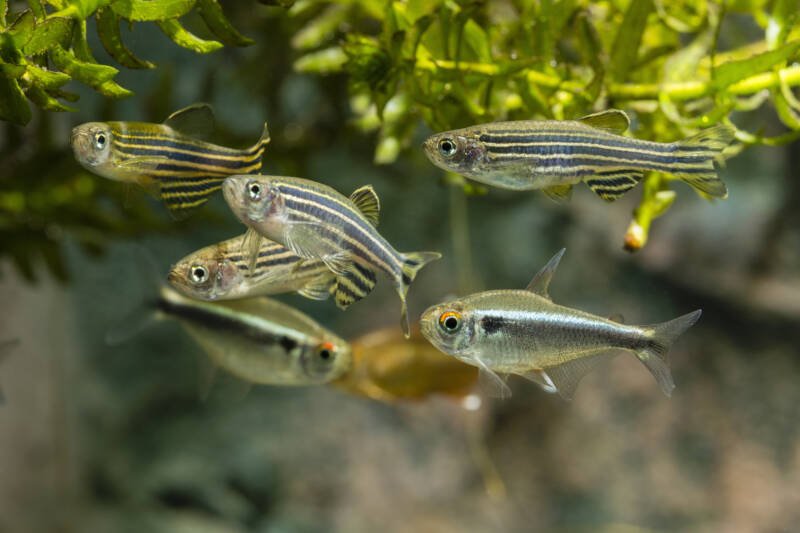
Minimum Tank Size: 10 gallons
These colorful danios feature stripes and spots, as their namesakes indicate.
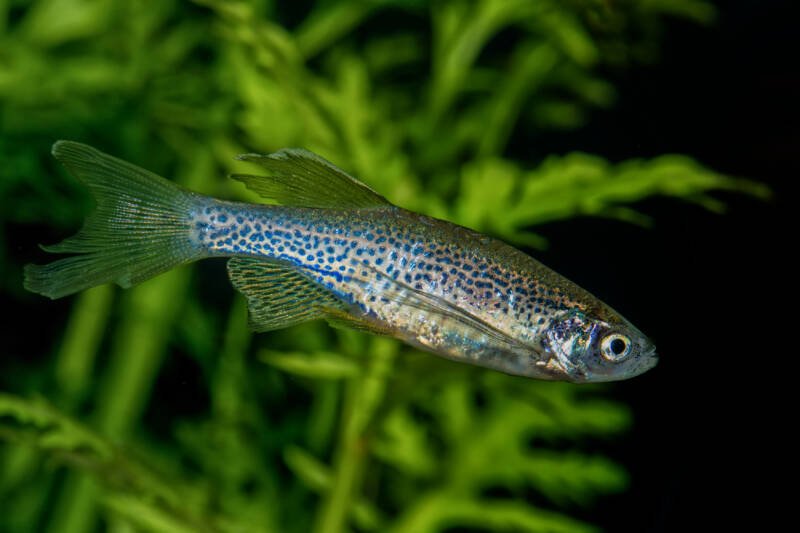
Coming in at around two inches (5 cm) in length, these fish tolerate an impressive range of water conditions but prefer their water on the cool side. They can even be kept in outdoor ponds.
Zebra danios thrive in a community environment. Plan on a school of at least five as lower numbers can prompt aggression, such as fin nipping. The danios will establish a hierarchy within the school.
They are highly active and explore all tank areas, making them excellent dither fish for more nervous species.
16. Coral Red Pencil Fish (Nannostomus mortenthaleri)
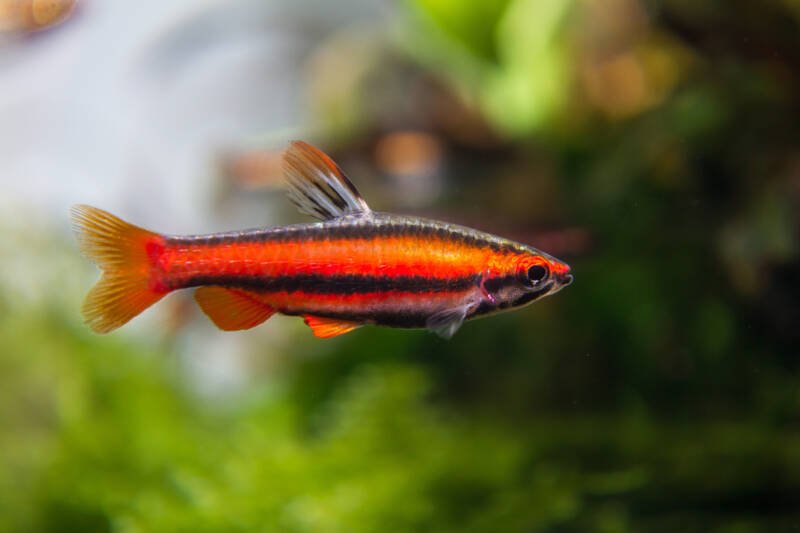
Minimum Tank Size: 30 gallons
The energetic coral red pencil fish needs a decent amount of swimming space. A long tank with a large open area, dark substrate, and low lighting makes the best display.
Pair them with other species that are not large, overly aggressive, or intolerant of the pencil fish’s activity levels.
Keep your pencil fish in a school of no less than 10 to spread out aggression among males. These fish move in tightly packed groups, and their vibrant red color is fabulous.
They are effective dither fish for shy bottom dwellers, giving a visual indication that the tank is safe.
Other Interesting Fish
These fish do not necessarily school but love the company of more of their kind and often hang out in groups.
17. Pygmy Corydoras (Corydoras pygmaeus)
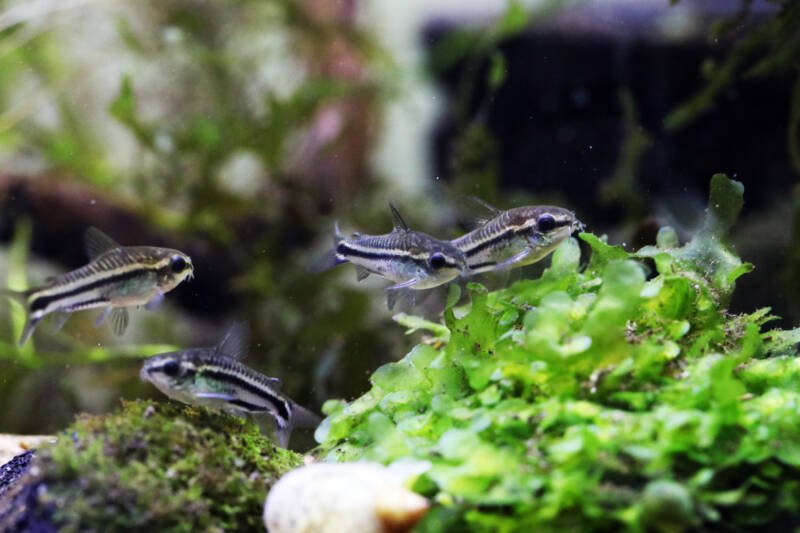
Minimum Tank Size: 10 gallons
The pygmy corydora is a tiny fish. Females reach an inch (2.5 cm) in length while males barely top three quarters (1.9 cm).
They have a narrow tolerance range for water conditions, so keep on top of tank maintenance.
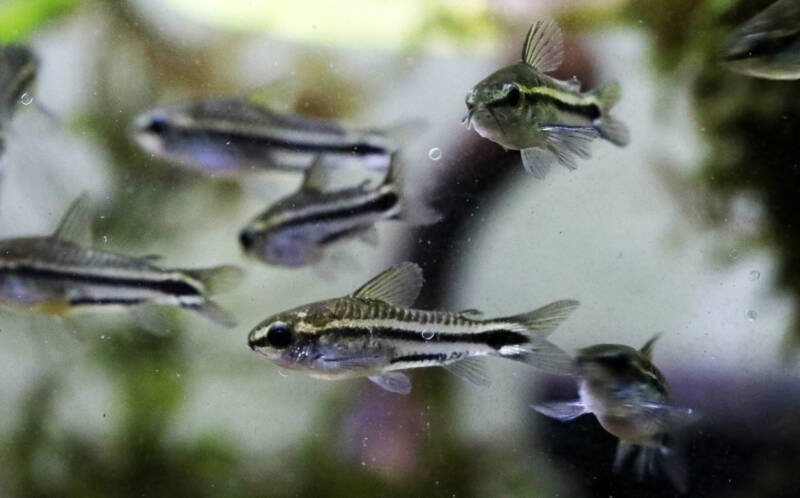
This species is more of a shoaling fish than a schooling one. A group of six is the minimum number to exhibit comfortable behavior; however, twice that number is even better.
These fish have unique feeding habits that are fun to watch. If one goes someplace new to feed, all follow in a close-knit group.
18. Spotted Blue Eye (Pseudomugil gertrudae)
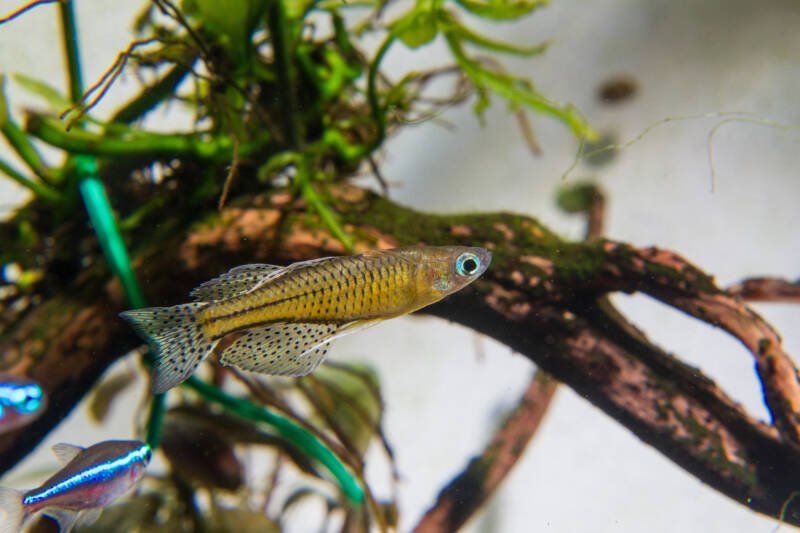
Minimum Tank Size: 20 gallons
You will fall in love with the intricate finnage of the spotted blue eye, including its semi-transparent, spotted, double dorsal fins.
Another shoaling fish, the spotted blue eye reaches between 1.2 to 1.4 inches (3 to 3.8 cm) and needs a large group of eight to 10 fish.
They pair best with other small species and are highly shy at first. With time, they grow comfortable in their environment and begin to shoal.
Setting up some hiding spaces and adding vegetation will promote confident behaviors. Consider also floating plants, dim lighting, and a dark substrate.
19. Celestial Pearl Danios (Danio margaritatus)
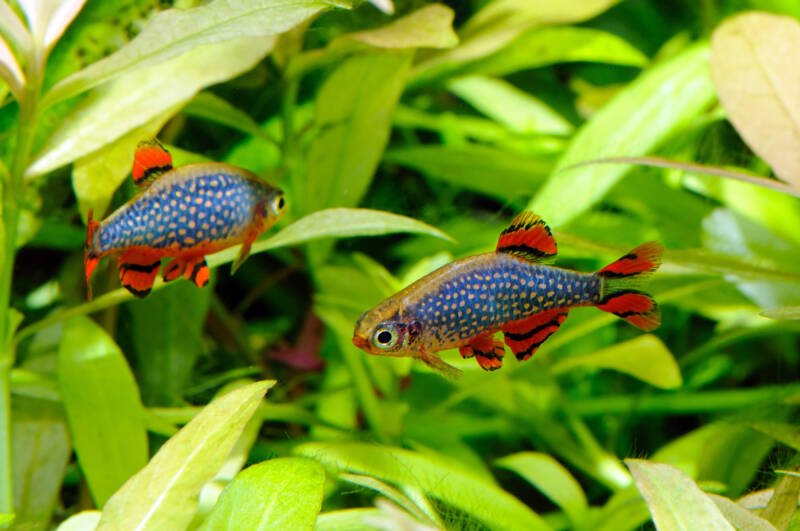
Minimum Tank Size: 15 gallons
With an orange belly and a deep blue back speckled with white “stars,” the celestial pearl danio mimics the twilight sky.
These tiny fish max out at only 0.8 to 0.9 inches (2 to 2.2 cm) in length. They are hardy, easy to feed, and adaptable to a wide range of water conditions.
Celestial pearl danios thrive in a minimum group of six, with more females than males.
While females congregate together, the males of this species will squabble for dominance. Keep a well-planted tank to allow the weaker males to shelter in the vegetation.
20. Amazon Puffer Fish (Colomesus asellus)
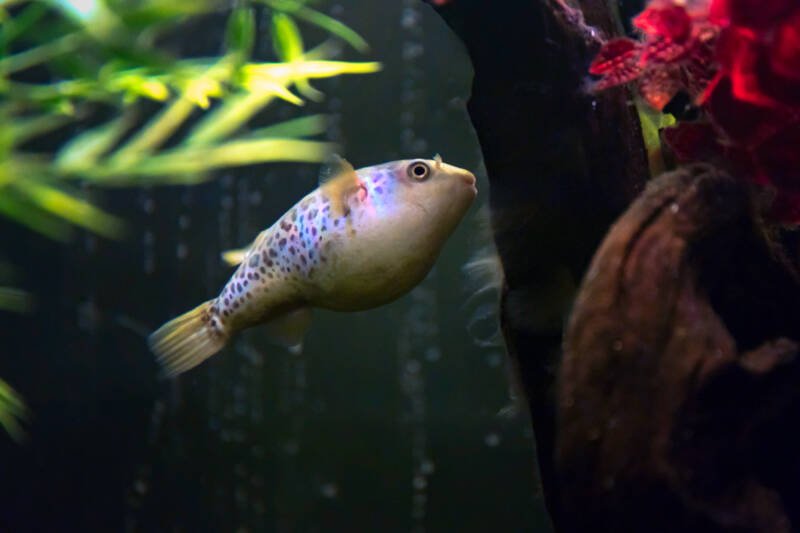
Minimum Tank Size: 20 gallons
This two-inch-long (5 cm) fish is a highly active, purely freshwater species that needs plenty of swimming space and a modest current.
Their sharp beak grows quickly, and they need regular feedings of hard-shelled foods.
They are a non-territorial species but may nip at the fins of slower swimming fish. Although not definitively a schooling or shoaling fish, the Amazon puffer prefers to be near others of its kind.
Keep a small group of six or more together with similarly-sized, peaceful fish, and they will live harmoniously in a community tank.
Closing Thoughts
Where one fish is beautiful, many are breathtaking! Schooling fish are undoubtedly an eye-catching addition to any home aquarium.
Keeping the conditions right for schooling behavior involves the proper tank setup and maintenance, adherence to recommended school sizes, and placement with compatible tank mates.
Follow these recommendations, and your tank will benefit from the activity and movement schooling fish provide!
Join the conversation! What are your favorite schooling species? With what other species do you pair them for the ultimate community tank?